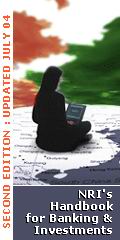|

 Daily News
Daily News
- Banking News
- IT News
- Insurance News
- BPO News
- Market News
 Banking
Banking
- Overview
- Basics
- Products
- Articles
- Policies
- More
 Technology
Technology
- Overview
- Major IT Cos
- Banking Software
- Features
- More
 More sections
More sections
- Finance
- BPO
- Insurance
- Jobs
- NRIs
- Banker's Club
- Business Humour
- Lifestyle
 Daily Rates Daily Rates
- Rupee Spot Rates
- Lending Rates
- Stock markets
- Converter
 Best Selling Books Best Selling Books
- Business Guide to India
- NRI's Handbook
- Report on BPO
- Whitepaper on Banking Systems
|
Click Here To Return To Daily News
Click For Other Top Stories
According to Fitch Ratings, tsunami that hit the southern parts of India on 26 December 2004 had a devastating effect on certain sections of society, but its effect on the financials of Indian banks is expected to be muted.
With industrial activity not being affected in any significant manner, banks’ exposure to the corporate sector is unlikely to deteriorate as an after-effect of the tsunami. Loans to distressed individuals could turn non-performing, but this will only be a small part of the total credit portfolio.
Tsunami effect has been most significant among fishermen and other people living near the coast and would likely have long-term implications on the lives of these communities. The loss to public and private property has been reported to be in excess of INR53 billion (USD1.2bn, 0.2% of India’s GDP), and reconstruction and rehabilitation efforts can only take effect over time. However, no long-term damage has been reported by any of the industries and power plants located in the region.
Banks operating in the affected areas have been spared any damage to their infrastructure, barring the loss of three branches in the Nicobar islands reported by State Bank of India. The low incidence of loss has been possible due to the more central location (away from the seashore) of the bank branches, and while operations were temporarily affected in the most severely hit areas, they have now been brought back to normal (or as close to normal as possible under the circumstances).
According to Fitch ratings, losses are likely to be among loans held by the affected individuals, including loans to fishermen and those mortgaged by properties that have been damaged. This segment however comprises the less affluent members of society, with individual loan amounts typically being less than INR100,000 (USD2,300), and their aggregation is unlikely to be a significant part of banks’ loans in the region. Losses are also possible in loans given to aquaculture units operating in the affected areas, though their numbers have been coming down over the years due to increased uncertainties in business.
Overall, the total loan loss provisioning requirement of banks as a direct result of the tsunami is estimated at less than INR1bn (USD23 million), which is a minute fraction (0.01%) of the INR8.6 trillion (USD195bn) loan portfolio held by Indian banks.
Donate to Tsunami victims
|
|
|
|
|
|
|
|
|
|
|
|
|
|
|
|
|
|
|
|
|
|
|
|
|
|
|
|
|
|
|
|
|
|
|
|
|
|
|
|
|
|
|
|
|
|
| |
-----------

|


